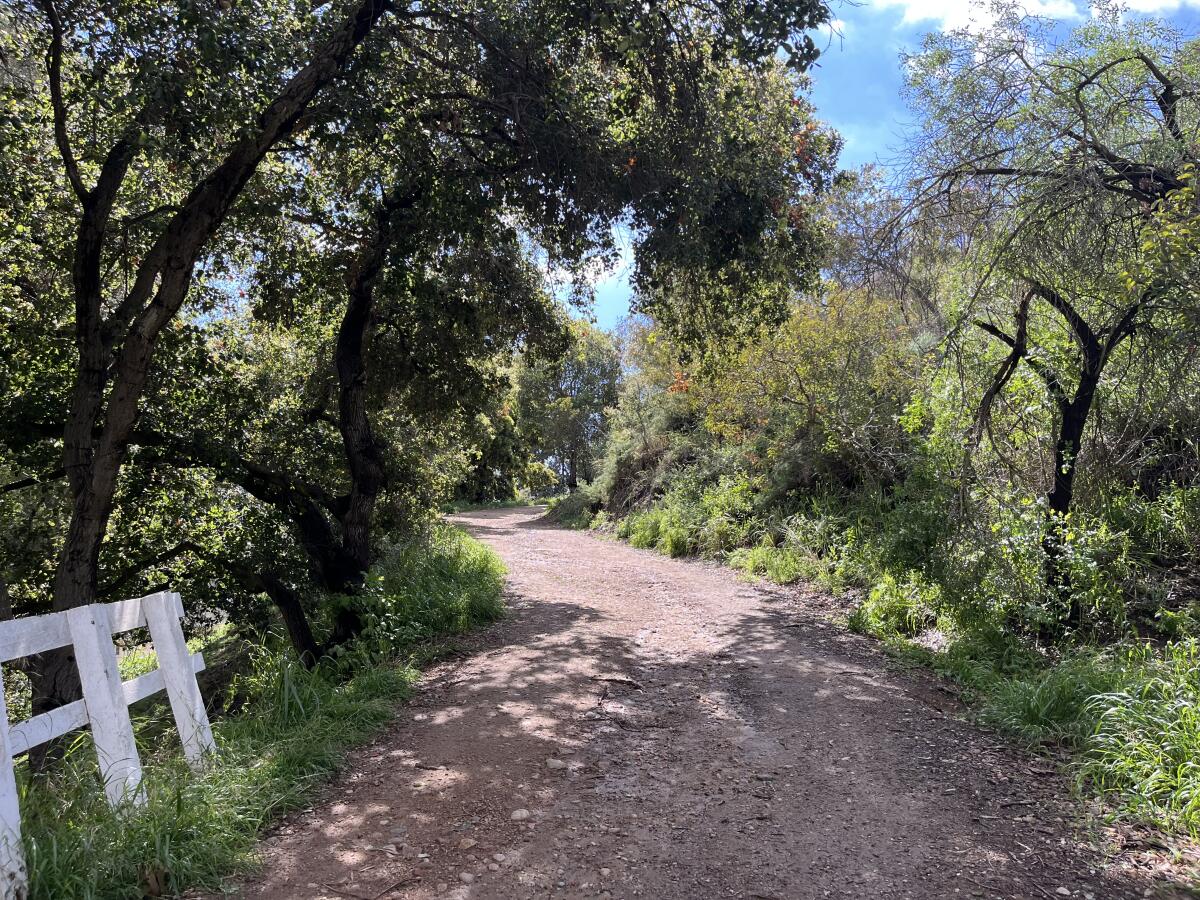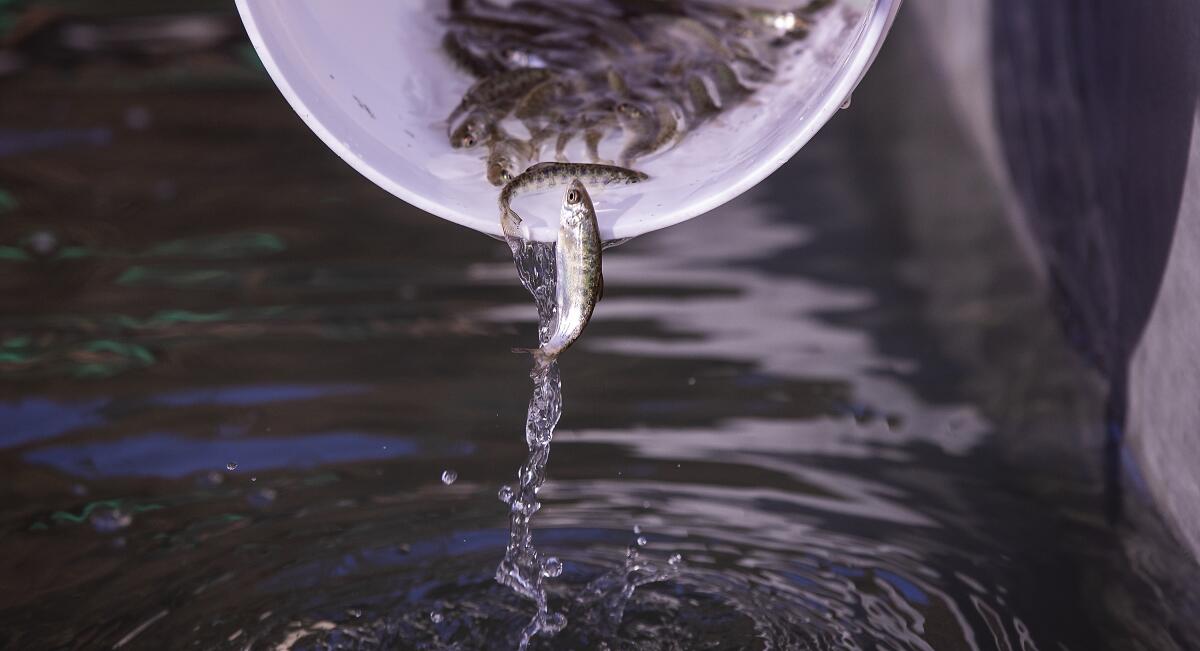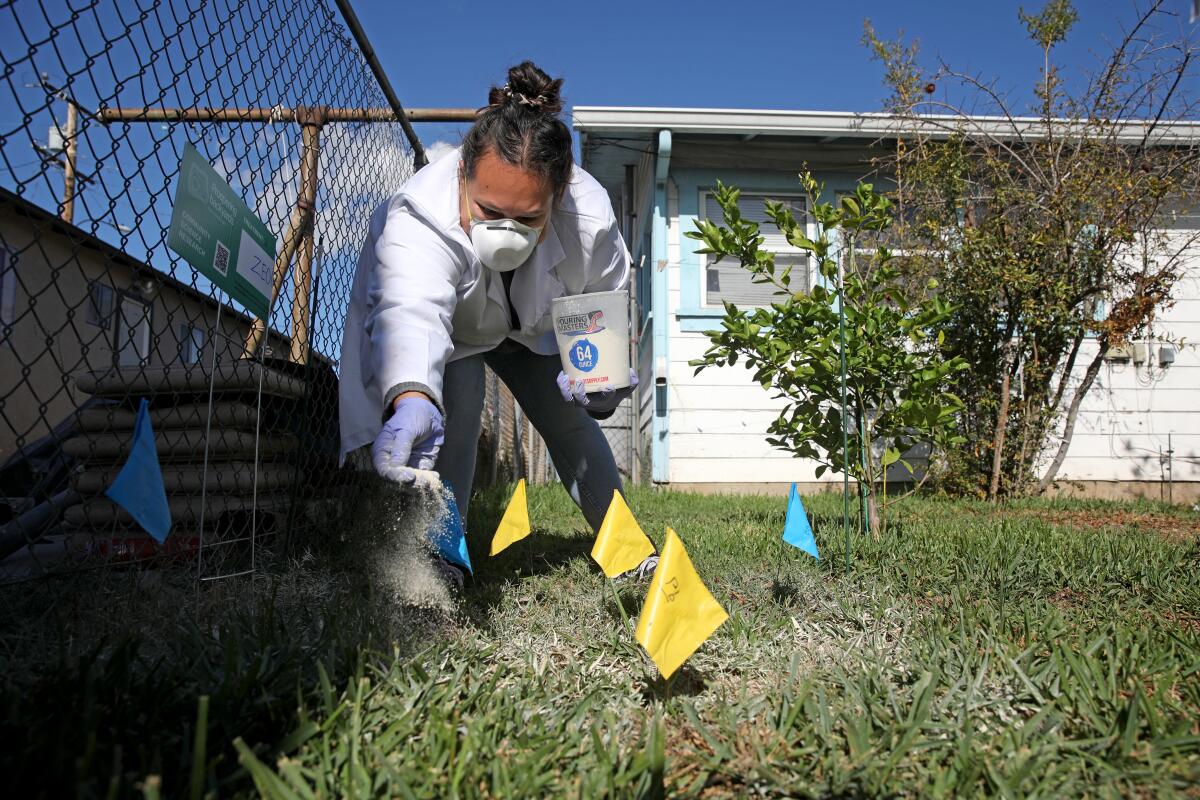Boiling Point: Is the drought over?

This story originally published in Boiling Point, a weekly newsletter about climate change and the environment. Sign up here to get it in your inbox.
It’s been raining like crazy in Los Angeles.
I’ve lived here most of my life, and I can’t remember the last time so much water poured from the sky for so long, battering the windows of my apartment and filling the L.A. River and greening the hillsides. When it dried off long enough for me to get outside on Sunday afternoon, Will Rogers State Historic Park in the Santa Monica Mountains looked spectacularly verdant.
It was water that California badly needs. As of Friday, snowpack in the Sierra Nevada mountain range was at 173% of normal. State officials announced that cities and farms would get 35% of requested water supplies, up from just 5% last year.
So does all this mean the drought is over, and we can take longer showers? Well, it’s not quite so simple.
For one thing, Southern California isn‚Äôt doing a great job of capturing rain for use, critics say ‚ÄĒ at last not yet. A new report from nonprofit Los Angeles Waterkeeper finds that L.A. County is missing big opportunities to fund stormwater capture projects ‚ÄĒ including building more parks and getting more pavement removed. Details here from The Times‚Äô Hayley Smith.
Then there‚Äôs groundwater. As much rain as we‚Äôve gotten, it‚Äôs a drop in the bucket for the underground aquifers that farmers in the Golden State‚Äôs Central Valley have been overpumping for decades, causing the ground to sink and roads to buckle. A new report from the Public Policy Institute of California finds that San Joaquin Valley farmers may be forced to leave nearly 900,000 acres dry over the next 20 years ‚ÄĒ one-fifth of currently irrigated land, as Times columnist George Skelton writes.
Yes, it’s been nearly a decade since state lawmakers passed the Sustainable Groundwater Management Act to try to make sure pumping doesn’t exceed natural groundwater recharge. But the law doesn’t take full effect until 2040. And in the meantime, big farmers continue to drain aquifers, and household wells continue to go dry. Here’s the story from my colleague Ian James.
Big picture, California and other Western states continue to use more water than nature provides ‚ÄĒ especially as climate change fuels a long-term drying trend. As The Times‚Äô Hayley Smith writes, ‚ÄúExperts said it will take more than a series of storms to make up for years of deficits. Some said declaring the drought over now ‚ÄĒ or possibly ever ‚ÄĒ would be a mistake.‚ÄĚ
‚ÄúWe‚Äôre now in a situation in California where there‚Äôs never really enough water anymore to do all of the things that everyone wants, and to declare the drought over, or the emergency over, I think would send the wrong signal,‚ÄĚ said Peter Gleick, co-founder and president emeritus of the Pacific Institute think tank. ‚ÄúI think people should still be cautious and careful and efficient.‚ÄĚ
In other words: It matters less whether we’re still in a drought and more that we continue to act like it.

That said, some environmentalists were furious that state regulators granted Gov. Gavin Newsom‚Äôs request to hold back more water in reservoirs and allow less of it to flow through rivers ‚ÄĒ to the detriment of struggling salmon species. Skelton wasn‚Äôt pleased either, with the Times columnist writing that Newsom and his appointees had used drought as an excuse to ‚Äúdrastically cut river flows needed by migrating little salmon in case the water is needed to irrigate San Joaquin Valley crops in summer.‚ÄĚ
Another battle is playing out at California‚Äôs Mono Lake, where state officials are thinking about limiting water exports to Los Angeles, as to prevent further environmental damage to a sensitive ecosystem. The L.A. Department of Water and Power is fighting to keep the spigot open, The Times‚Äô Louis Sahag√ļn reports ‚ÄĒ even though just 1% of the city‚Äôs water supply is at stake.
The Klamath River along the California-Oregon border is another hot spot for water conflict, even after recent rains. Grist‚Äôs Jake Bittle and High Country News‚Äô B. ‚ÄėToastie‚Äô Oaster report that as far as Indigenous tribes are concerned, the federal government is once again sacrificing their sacred fish to benefit potato farmers ‚ÄĒ some of whom supply In-N-Out Burger.
The Colorado River Basin, meanwhile, continues to spiral into crisis, with not nearly as much snowpack the last few months as California has received. At Lake Powell along the Utah-Arizona border, federal officials are considering drilling holes through Glen Canyon Dam ‚ÄĒ or through the rock around the dam ‚ÄĒ to make sure they can keep generating hydropower as water levels fall. But some environmentalists say the feds should invest in solar and wind energy instead, as James reports.
It‚Äôs hard to know what the next few months hold for water supply in California and the American West. But climate models tell us that a drier future ‚ÄĒ punctuated by harsher bursts of rain and snow, like we‚Äôve seen recently ‚ÄĒ are a safe bet.
So let’s keep planning for the long term, and enjoy the snow-capped mountains and verdant hillsides while we have them.
Here’s what else is happening around the West:
TOP STORIES

Restaurants that depend on gas cooking, such as tabletop Korean barbecues, are grappling with huge January gas bills ‚ÄĒ including a tab of more than $13,000 at one spot in L.A.‚Äôs Chinatown. Restaurant owners are talking about raising prices to cope, and even temporarily shutting down, The Times‚Äô Stephanie Breijo and Cindy Carcamo report. Natural gas prices have been so high that even the architect who designed the Gas Company Tower in downtown L.A. ‚ÄĒ headquarters of Southern California Gas Co. ‚ÄĒ told my colleague Terry Castleman that he wishes his home had fewer gas appliances. Are natural forces such as the weather to blame for high gas prices, or is market manipulation at work? The San Diego Union-Tribune‚Äôs Rob Nikolewski explored whether there are similarities between the recent natural gas price shocks and California‚Äôs early-2000s energy crisis.
High natural gas prices have shined a spotlight on the gas utility industry‚Äôs ongoing efforts to block the conversion of homes and businesses to electric heating and cooking. In Colorado, new documents show that utility giant Xcel Energy played a leading role in creating an anti-electrification group, Sam Brasch reports CPR News. And in Oregon, major utility company NW Natural gave $51,000 to a group calling itself ‚ÄúEugene Residents for Energy Choice,‚ÄĚ four days after Eugene became the first city in Oregon to ban gas hookups in new housing, per Jashayla Pettigrew at KOIN 6 News. Federal officials, meanwhile, continue to press for cleaner appliances that generate less climate and air pollution. Half the gas stoves on the market wouldn‚Äôt be legal under the Biden administration‚Äôs proposed efficiency rule for new stoves, Brian Dabbs reports for E&E News.
People without homes are on the front lines of the climate crisis. My colleague Summer Lin wrote a painful but important story about some of the unhoused Angelenos who died during last summer‚Äôs worst heat wave ‚ÄĒ and the many whose stories we will probably never hear. ‚ÄúFolks who already have preexisting conditions, whether that be diabetes, kidney and heart conditions or even mental health conditions, their body is already allocating much of its energy to deal with those underlying conditions,‚ÄĚ one UCLA researcher said. ‚ÄúPeople who are exposed environmentally to that heat, it doesn‚Äôt allow their body to recover.‚ÄĚ
POLITICAL CLIMATE

California lawmakers allocated several million dollars to clean up toxic lead from grassy sidewalk medians around the Exide battery recycling plant in Los Angeles County ‚ÄĒ but the money never got used. The agency in charge of the $750-million cleanup forfeited those funds after failing to use them on time, The Times‚Äô Tony Briscoe and Jessica Garrison report. It‚Äôs only the latest revelation from our ongoing investigation into the Exide fiasco. State officials insist they‚Äôve got a communication problem on their hands, but people with toxic contamination in their yards say communication is not the issue.
A state appeals court has blocked UC Berkeley from building housing for students and low-income families, citing the California Environmental Quality Act, or CEQA. The court ruled that under the environmental law, the university should have evaluated potential ‚Äúnoise impacts‚ÄĚ from students who might get drunk and hold ‚Äúunruly parties,‚ÄĚ my colleague Teresa Watanabe reports. UC Berkeley officials said they were ‚Äúdismayed by this unprecedented and dangerous decision to dramatically expand CEQA‚ÄĚ ‚ÄĒ a decision critics say could actually hurt the environment, by making it harder for California to build apartments within city centers that make it easier for people to walk and take public transit rather than commute long distances in their cars.
California lawmaker ‚Ā¶Lena Gonzalez, a state senator from Long Beach, is once again trying to force the state‚Äôs public pension funds to divest from fossil fuels. But the fate of her bill likely hinges on powerful labor unions that have yet to take a stance, Tiffany Stecker reports for Bloomberg Law. The pension funds have an estimated $15 billion invested in fossil fuels.
THE ENERGY TRANSITION
California‚Äôs latest renewable energy plan calls for adding 86 gigawatts of clean power to the grid in the next 12 years ‚ÄĒ more than the state‚Äôs entire generating capacity right now. Details here from Canary Media‚Äôs Jeff St. John on the ambitious target set by the California Public Utilities Commission. Some of the state‚Äôs renewable energy needs could be met by rooftop solar panels and home batteries, with St. John also reporting that Pacific Gas & Electric will test two ‚Äúvirtual power plants‚ÄĚ involving rooftop solar and battery storage this summer. At the same time, Utility Dive‚Äôs Kavya Balaraman reports that state officials are poised to reject a proposal by rooftop solar company Sunnova to build local microgrids to power new neighborhoods, without any involvement from PG&E and other investor-owned utility companies. And it‚Äôs not yet clear if California is ready to take advantage of major federal funding for neighborhood-level ‚Äúcommunity solar‚ÄĚ installations, per Dan Gearino at Inside Climate News.
The federal government‚Äôs push for ocean wind turbines off the West Coast continues ‚ÄĒ slowly. The Biden administration is starting a 20-month study of how to build out electric transmission lines for offshore wind, David Iaconangelo reports for E&E News. On the other side of the country, President Biden‚Äôs appointees have slashed by two-thirds the amount of ocean area they‚Äôll open to wind turbines on the Gulf of Mexico ‚ÄĒ in part to reduce conflicts with oil and gas drilling, Tristan Baurick reports for the Times-Picayune/New Orleans Advocate. But that‚Äôs still nearly 200,000 acres for offshore wind, which companies say is plenty.
A federal judge has denied another request by conservationists to temporarily block construction of a huge lithium mine in Nevada, saying the company behind the Thacker Pass mine can ‚Äúunfortunately‚ÄĚ start ripping out sagebrush. Here‚Äôs the story from Scott Sonner at the Associated Press. Conservation activists were frustrated by the decision. They were happier with the Biden administration‚Äôs announcement that it will protect California spotted owls under the Endangered Species Act. Logging and climate change are among the threats to the species, the Associated Press‚Äô Olga R. Rodriguez reports.
AROUND THE WEST
A lawsuit alleges that Recreation.gov is generating hundreds of millions of dollars for the private contractor that runs the website through possibly illegal ‚Äújunk fees‚ÄĚ ‚ÄĒ like making you pay $6 to enter the Mt. Whitney lottery. As someone has been trying for several years to score a permit to hike Mt. Whitney, I‚Äôll admit I‚Äôm not exactly a neutral party here. Check out the story from Lori Sonken and Kurt Repanshek at National Parks Traveler, who report that the site‚Äôs operator, Booz Allen Hamilton, has said the allegations are ‚Äúgrossly inaccurate and reflect a fundamental lack of understanding of Booz Allen‚Äôs work supporting the government.‚ÄĚ The consulting firm is perhaps best known for formerly employing whistleblower Edward Snowden.
The federal Bureau of Land Management is poised to issue final approval of a 550-mile power line to carry wind energy from New Mexico to Arizona and California. Local conservationists continue to say the line will damage sensitive ecosystems along the San Pedro River corridor, but they haven‚Äôt been able to stop the project, Henry Brean reports for the Arizona Daily Star. More transmission lines such as this one will almost certainly be needed to wean the West off of fossil fuels. They‚Äôre expected to create jobs, too. Wyoming Public Radio‚Äôs Caitlin Tan reports that the community college in Rock Springs ‚ÄĒ a historic coal town ‚ÄĒ has added a power-line training program, to support young people who want to stay in Wyoming as fossil fuel jobs dry up.
Drought can kill forests slowly ‚ÄĒ but extreme heat can seemingly harm them a lot faster. New research into the 2021 heat dome in the Pacific Northwest shows that ‚Äúheat stress causes more immediate and acute damage than drought,‚ÄĚ although the long-term effects on trees are less clear, Sarah Trent writes for High Country News. Despite the growing threat posed by extreme heat storms and other consequences of the climate crisis, Oregon‚Äôs largest electric utilities now say they‚Äôll keep buying coal power from Montana‚Äôs Colstrip plant until 2030 ‚ÄĒ five years longer than previously planned, per Tom Lutey at the Billings Gazette.
ONE MORE THING

Until this week, I had never seen the ‚ÄúCrying Indian‚ÄĚ TV ad that first aired in the 1970s, decrying pollution from smokestacks, litter and other sources. It packs a punch, warning against the continued destruction of our air, rivers and natural landscapes.
It has also faced criticism for its stereotypical portrayal of a Native American man and appropriation of Indigenous culture. That’s why the National Congress of American Indians has acquired rights to the ad and is retiring it permanently, as Terry Tang reports for the Associated Press. The ad might have been useful once upon a time. But it has arguably outlived that usefulness.
‚ÄúThere‚Äôs no agency for that sad so-called Indian guy sitting in a canoe crying,‚ÄĚ said Jennifer J. Folsom, a journalism professor at Colorado State University and citizen of the Choctaw Nation of Oklahoma. ‚ÄúI think it has done damage to public perception and support for actual Native people doing things to protect the land and protect the environment.‚ÄĚ
Times change, and we change with them.
That’s all for today. We’ll be back in your inbox on Thursday. If you enjoyed this newsletter, or previous editions, please consider forwarding it to your friends and colleagues. For more climate and environment news, follow @Sammy_Roth on Twitter.
Toward a more sustainable California
Get Boiling Point, our newsletter exploring climate change, energy and the environment, and become part of the conversation ‚ÄĒ and the solution.
You may occasionally receive promotional content from the Los Angeles Times.




